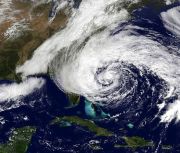Superstorm Sandy

A pre-Halloween storm of scary proportions
by Catherine McNiff
 The eye of the storm bears down on the eastern seaboard Hurricane Links
Other Great Weather Disasters
Additional Resources |
Before it hit the continental U.S., news media were coming up with witty monikers for the storm which came to be known as Superstorm Sandy. It started as the Perfect Storm, then Frankenstorm, until finally, Hurricane Sandy met up with a nor'easter and became Superstorm Sandy--a name those who were in her path won't soon forget.
Sandy's Dark and Deadly Path
After killing almost 70 in the Caribbean, Sandy smashed into the eastern seaboard of the U.S. on Monday, Oct. 29, 2012, bringing with her high winds, destructive tides, and snow. Hardest hit were New York, New Jersey, Pennsylvania, and Maryland. With a death toll climbing past 125 and an economic cost estimated at $50 billion, Superstorm Sandy is a force to be reckoned with. In comparison, 2011's Hurricane Irene claimed 44 lives and cost $10 billion, while Katrina still reigns as this country's and century's worst natural disaster, with at least 1,836 people lost and damages estimated at around $125 billion. Superstorm Sandy's dubious honors include the highest storm surge of 13.88 ft (4.23 m) at Battery Park, N.Y; and record low barometer readings in New Jersey, Pennsylvania, and Maryland around the 948 mb mark. Sandy was also, even against hurricane standards, exceptionally large, with hurricane-force winds covering a 175-mile distance from her center, and tropical storm-force winds extending beyond a 500-mile radius. With such wind velocity and range, it is not surprising that the U.S. Department of Energy reported more than 8.6 million people without power in the superstorm's aftermath, leaving more people in the dark than any other storm in history.
Exacerbating the area's difficulties was a midweek Nor'easter which overlapped much of Sandy's territory and caused more power outages and major headaches, including disruption of supply lines for food and fuel. Even two weeks after the storm, some 200,000 customers were without power in the northeast.
A Race not Run
Apart from the obvious and devastating loss of life and property, Superstorm Sandy also claimed the 2012 New York Marathon. The race, which was to take place on Nov. 4, just 6 days after the storm hit, was originally scheduled to run as usual, a "Let them run" call made by Mayor Bloomberg in hopes of raising spirits and showing the fighting spirit of New Yorkers. Instead, the race became a "source of controversy and division" which split the city, worried about diversion of resources, and caused the mayor to take back the race. "Over the course of the week, it became clear that the marathon, which is really one of the very best days in the life of the city, which is a moment of unity and happiness and joy and a celebration of everything that is New York, had become divisive and had become controversial," said Bloomberg aide Howard Wolfson. The race was cancelled on Friday, Nov. 2 and the resources such as water, generators, and portable toilets were redistributed to help those displaced by the storm.
Global Warming to Blame?
Some see the relatively recent increase in frequency and intensity of storm systems as a symptom of global warming. It has been scientifically demonstrated that the oceans are warmer and their levels are higher. In the case of Superstorm Sandy, the worldwide measurable rise in sea level surely lent deadly force to tides and resulted in the most destructive aspect of the storm: surging sea water. Does it make sense that the warmer seas intensify storm energy, which is then harnessed with the increased moisture in Earth's atmosphere, resulting in more volume and frequency of precipitation? Most definitely. But it is misleading to say that global warming caused Superstorm Sandy. . .it is more likely that global warming accentuated many of her basic stormy traits.
- More about Major Disasters







